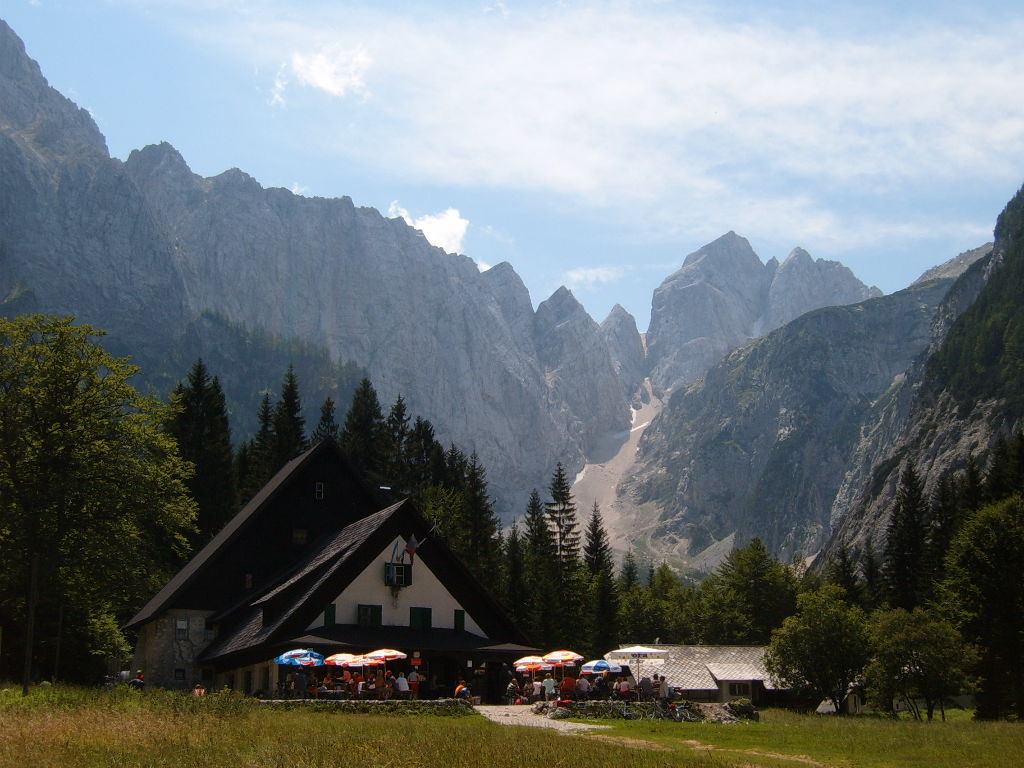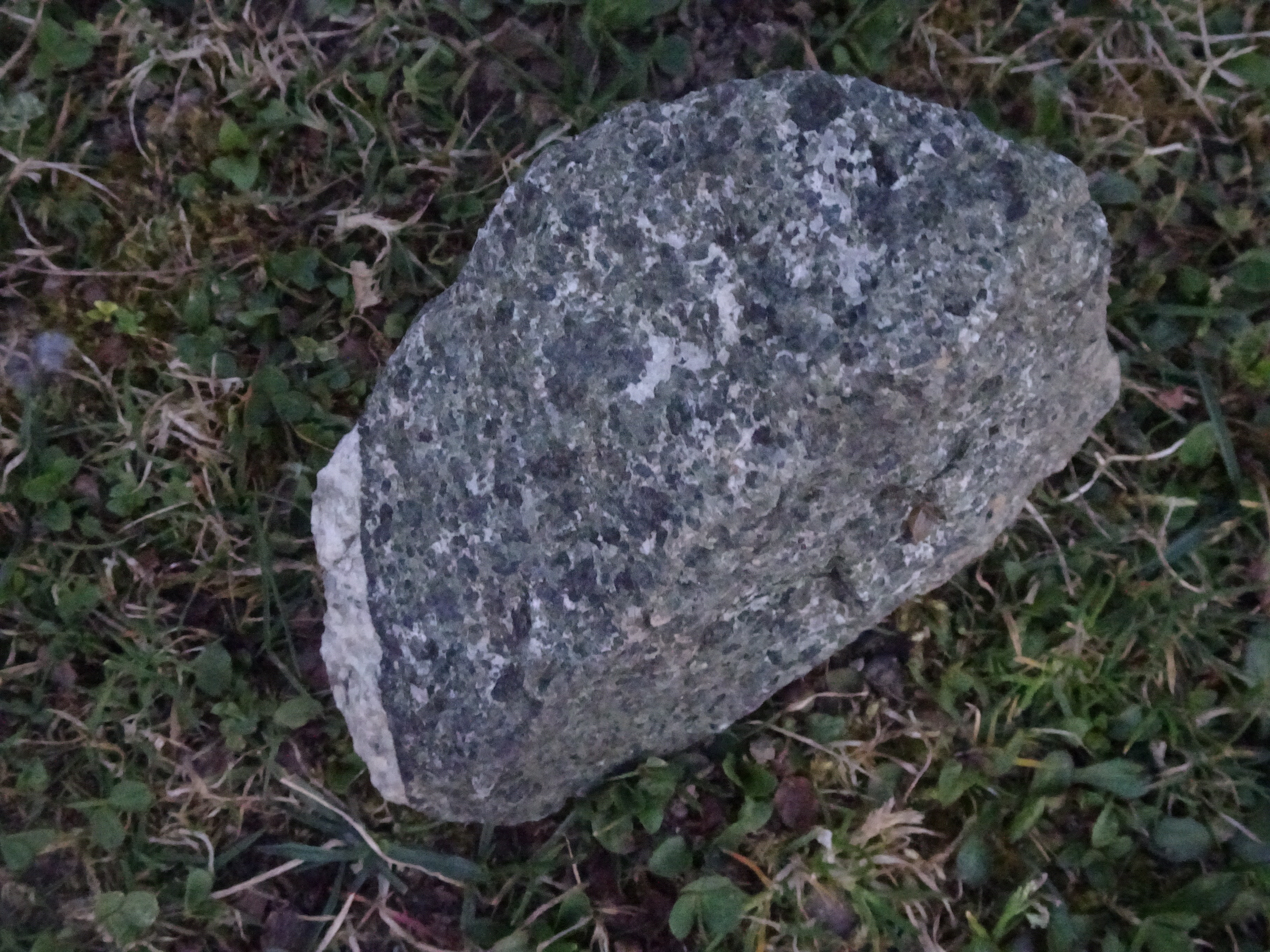|
Vintgar Gorge
The Vintgar Gorge ( sl, soteska Vintgar) or Bled Gorge () is a gorge in northwestern Slovenia in the municipalities of Gorje and Bled, four kilometers northwest of Bled. Carved by the Radovna River, it is the continuation of the Radovna Valley. The sheer canyon walls are high, with a total slope measuring about . The stream has created many erosive features such as pools and rapids, and terminates in the picturesque Šum Falls (literally, 'noisy falls'), the largest river waterfall in Slovenia. History Until 1890, the gorge was mainly inaccessible, except for two points at which the Radovna could be reached, and a bridge over Šum Falls was already built in 1878. The rest of the gorge was explored in 1891 by the mayor of Gorje, Jakob Žumer, and by Benedikt Lergetporer, a prominent photographer of the era. In 1893 the gorge was equipped with wooden observation walkways and bridges with great effort and was opened to the public on August 26, 1893. The walkways, which were ... [...More Info...] [...Related Items...] OR: [Wikipedia] [Google] [Baidu] |
Podhom
Podhom () is a settlement in the Municipality of Gorje in the Upper Carniola region of Slovenia Slovenia ( ; sl, Slovenija ), officially the Republic of Slovenia (Slovene: , abbr.: ''RS''), is a country in Central Europe. It is bordered by Italy to the west, Austria to the north, Hungary to the northeast, Croatia to the southeast, an .... In addition to the main settlement, it also consists of the hamlets of Spodnji Graben, Gabrce, Vintgar, and Vršce to the west. Name The name ''Podhom'' is a fused prepositional phrase that has lost its case ending, from ''pod'' 'below' + ''Hom'' 'Hom Hill'. Hom Hill (834 m) stands north of Podhom. The name ''Podhom'' therefore literally means 'below Hom Hill'. Podhom was known as ''Buchheim'' in German in the past.''Intelligenzblatt zur Laibacher Zeitung'', no. 141. 24 November 1849, p. 16. Notable people Notable people that were born or lived in Podhom include: * Albin Belar (1864–1939), seismologist * Andrej Žumer (1847–1903), t ... [...More Info...] [...Related Items...] OR: [Wikipedia] [Google] [Baidu] |
Canyons And Gorges Of Slovenia
A canyon (from ; archaic British English spelling: ''cañon''), or gorge, is a deep cleft between escarpments or cliffs resulting from weathering and the erosive activity of a river over geologic time scales. Rivers have a natural tendency to cut through underlying surfaces, eventually wearing away rock layers as sediments are removed downstream. A river bed will gradually reach a baseline elevation, which is the same elevation as the body of water into which the river drains. The processes of weathering and erosion will form canyons when the river's headwaters and estuary are at significantly different elevations, particularly through regions where softer rock layers are intermingled with harder layers more resistant to weathering. A canyon may also refer to a rift between two mountain peaks, such as those in ranges including the Rocky Mountains, the Alps, the Himalayas or the Andes. Usually, a river or stream carves out such splits between mountains. Examples of mountain-type c ... [...More Info...] [...Related Items...] OR: [Wikipedia] [Google] [Baidu] |
Tourist Attractions In Slovenia
Tourism is travel for pleasure or business; also the theory and practice of touring (other), touring, the business of attracting, accommodating, and entertaining tourists, and the business of operating tour (other), tours. The World Tourism Organization defines tourism more generally, in terms which go "beyond the common perception of tourism as being limited to holiday activity only", as people "travelling to and staying in places outside their usual environment for not more than one consecutive year for leisure and not less than 24 hours, business and other purposes". Tourism can be Domestic tourism, domestic (within the traveller's own country) or International tourism, international, and international tourism has both incoming and outgoing implications on a country's balance of payments. Tourism numbers declined as a result of a strong economic slowdown (the late-2000s recession) between the second half of 2008 and the end of 2009, and in consequence of t ... [...More Info...] [...Related Items...] OR: [Wikipedia] [Google] [Baidu] |
Triglav National Park
Triglav National Park (TNP) ( sl, Triglavski narodni park) is the only national park in Slovenia. It was established in its modern form in 1981 and is located in the northwestern part of the country, respectively the southeastern part of the Alpine massif. Mount Triglav, the highest peak of the Julian Alps, stands almost in the middle of the national park. From it the valleys spread out radially, supplying water to two large river systems with their sources in the Julian Alps: the Soča and the Sava, flowing to the Adriatic and Black Sea, respectively. History The proposal for the protection of the Triglav Lakes Valley area was first put forward by the seismologist Albin Belar in 1906 or 1908. However, the proposal was not accepted, as there was no legal base for it and the then valid laws prohibited any restriction of pasture. The strategic basis for the protection of the area, titled ''The Memorandum'' (), and which explicitly mentioned the proposal of Belar, was submitted to ... [...More Info...] [...Related Items...] OR: [Wikipedia] [Google] [Baidu] |
Upper Sava Valley
The Upper Sava Valley ( sl, Zgornjesavska dolina) is an alpine valley in the Upper Carniola region of Slovenia. The Sava Dolinka River flows along it. It begins in Rateče at an elevation of 870 m and ends at Moste at 560 m. It is the geographical border between the Julian Alps and the Karawanks. It was created on a tectonic fault that runs down the middle of the valley. Its geomorphological forms are a result of the actions of the river and glaciers. A number of smaller valleys lead into it from both sides. The largest settlements in the valley are Kranjska Gora and Jesenice Jesenice (, german: Aßling''Leksikon občin kraljestev in dežel zastopanih v državnem zboru'', vol. 6: Kranjsko. 1906. Vienna: C. Kr. Dvorna in Državna Tiskarna, p. 144.) is a Slovenian town and the seat of the Municipality of Jesenice on the .... Some of the traditional and modern settlements are located on active alluvial fans that may cause a threat of the modelled torrents and debris flows. Ref ... [...More Info...] [...Related Items...] OR: [Wikipedia] [Google] [Baidu] |
Triassic
The Triassic ( ) is a geologic period and system which spans 50.6 million years from the end of the Permian Period 251.902 million years ago ( Mya), to the beginning of the Jurassic Period 201.36 Mya. The Triassic is the first and shortest period of the Mesozoic Era. Both the start and end of the period are marked by major extinction events. The Triassic Period is subdivided into three epochs: Early Triassic, Middle Triassic and Late Triassic. The Triassic began in the wake of the Permian–Triassic extinction event, which left the Earth's biosphere impoverished; it was well into the middle of the Triassic before life recovered its former diversity. Three categories of organisms can be distinguished in the Triassic record: survivors from the extinction event, new groups that flourished briefly, and other new groups that went on to dominate the Mesozoic Era. Reptiles, especially archosaurs, were the chief terrestrial vertebrates during this time. A specialized subgroup of archo ... [...More Info...] [...Related Items...] OR: [Wikipedia] [Google] [Baidu] |
Bohinj Glacier
Bohinj (; german: Wochein), or the Bohinj Valley ( sl, Bohinjska dolina) or Bohinj Basin ( sl, Bohinjska kotlina), is a 20 km long and 5 km wide basin in the Julian Alps, in the Upper Carniola region of northwestern Slovenia. It is traversed by the Sava Bohinjka river. Its main feature is the periglacial Lake Bohinj ( sl, Bohinjsko jezero). Bohinj is part of the Municipality of Bohinj, the seat of which is Bohinjska Bistrica. Geography The basin consists of four geographic units: the Lower Valley ( sl, Spodnja dolina), Upper Valley (), Ukanc Basin or Lake Basin (; Jezerska kotlina), and Nomenj Basin (). It is bounded by the Komarča head wall on one end and Soteska Canyon at the other. The Lower Bohinj Mountain Range represents its southern border. The Sava River has carved a canyon between the Jelovica and Pokljuka plateaus in the east. To the north, Mount Triglav, Slovenia's highest mountain, is also a part of the municipality. The Sava Bohinjka (which merges with th ... [...More Info...] [...Related Items...] OR: [Wikipedia] [Google] [Baidu] |
Bohinj
Bohinj (; german: Wochein), or the Bohinj Valley ( sl, Bohinjska dolina) or Bohinj Basin ( sl, Bohinjska kotlina), is a 20 km long and 5 km wide basin in the Julian Alps, in the Upper Carniola region of northwestern Slovenia. It is traversed by the Sava Bohinjka river. Its main feature is the periglacial Lake Bohinj ( sl, Bohinjsko jezero). Bohinj is part of the Municipality of Bohinj, the seat of which is Bohinjska Bistrica. Geography The basin consists of four geographic units: the Lower Valley ( sl, Spodnja dolina), Upper Valley (), Ukanc Basin or Lake Basin (; Jezerska kotlina), and Nomenj Basin (). It is bounded by the Komarča head wall on one end and Soteska Canyon at the other. The Lower Bohinj Mountain Range represents its southern border. The Sava River has carved a canyon between the Jelovica and Pokljuka plateaus in the east. To the north, Mount Triglav, Slovenia's highest mountain, is also a part of the municipality. The Sava Bohinjka (which merges with th ... [...More Info...] [...Related Items...] OR: [Wikipedia] [Google] [Baidu] |
Ribnica Gorge
Ribnica may refer to: Bosnia and Herzegovina * Ribnica (Kakanj), a village Croatia * Ribnica, Croatia, a village in central Croatia Macedonia * Ribnica, Mavrovo and Rostuša, a settlement in the municipality of Mavrovo and Rostuša Montenegro * Ribnica, the old name for Podgorica, the capital of Montenegro * Ribnica (fortress), a fortress * Ribnica (river), a river * FK Ribnica, a football club Serbia * Lake Ribnica * Ribnica (Kraljevo), a town in City of Kraljevo * Ribnica, a settlement in Kraljevo Slovenia * Municipality of Ribnica, a municipality * Municipality of Ribnica na Pohorju, a municipality * Ribnica, Brežice, a settlement in the Municipality of Brežice * Ribnica na Pohorju, a settlement in the Municipality of Ribnica na Pohorju * Ribnica, Pivka, a settlement in the Municipality of Pivka * Ribnica, Ribnica, a settlement in the Municipality of Ribnica * RD Ribnica, a handball club based in Ribnica, Ribnica * Spodnja Ribnica, a hamlet of Ri ... [...More Info...] [...Related Items...] OR: [Wikipedia] [Google] [Baidu] |
Pohorje
Pohorje (), also known as the Pohorje Massif or the Pohorje Mountains (german: Bachergebirge, ''Bacherngebirge'' or often simply ''Bachern''), is a mostly wooded, medium-high mountain range south of the Drava River in northeastern Slovenia. According to the traditional AVE classification it belongs to the Southern Limestone Alps. Geologically, it forms part of the Central Alps and features silicate metamorphic and igneous rock. Pohorje is sparsely populated with dispersed villages. There are also some ski resorts. Geography Pohorje is an Alpine mountain ridge with domed summits south of the Drava. It roughly lies in the triangle formed by the towns of Maribor (to the east), Dravograd (to the west) and Slovenske Konjice (to the south). To the northwest, it is bounded by the Mislinja River, to the south by the Vitanje Lowlands (), to the east it descends to the Drava Plain () and to the southeast it descends to the Pohorje Foothills (). It measures about from east to west an ... [...More Info...] [...Related Items...] OR: [Wikipedia] [Google] [Baidu] |
.jpg)






